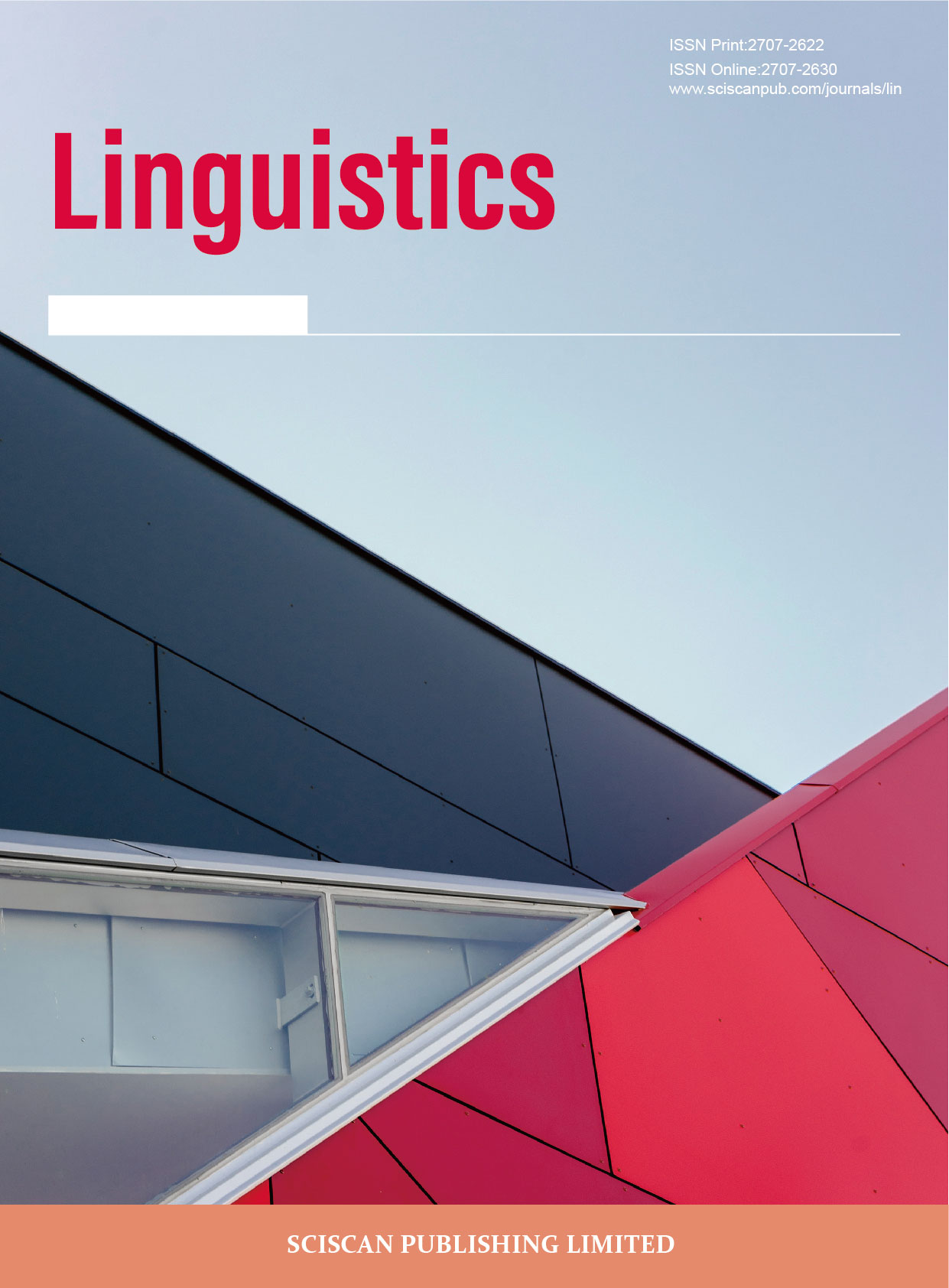汉语与肯尼亚斯瓦布里语语音系统对比分析
Contrastive Analysis of Phonological Systems —Standard Chinese and Swahili in Kenya
- Authors: 蓝玉茜
-
Information:
厦门大学海外教育学院,厦门
-
Keywords:
Kenya; First Language Interference; Standard Chinese; Swahili; Contrastive Analysis肯尼亚; 第一语言干扰; 标准汉语; 斯瓦希里语; 对比分析
- Abstract: Under the ‘Belt and Road’ initiative, as economic and culturalexchanges between Kenya and China deepen, Chinese language is playingan increasingly important role in Kenya’s education system. This paperemploys contrastive analysis theory to explore the challenges faced by Swahilinative speakers when learning Putonghua. The article begins by introducingKenya's multilingual policy and the context of Putonghua teaching in Kenya.Subsequently, the paper provides a detailed comparison of the phoneticsystems of Putonghua and Swahili, including contrasts in their vowel andconsonant systems. Through an in-depth analysis of the phonetic features ofboth languages, the study reveals the complexity of Putonghua’s tonal systemand its rich assortment of consonants, as well as the relatively simple syllablestructure and consonant system of Swahili. The findings indicate that Swahilinative speakers may encounter a range of challenges when learning Putonghua,particularly in achieving pronunciation accuracy, such as adapting to thedifferences between rounded and unrounded vowels and special consonantphonemes in Putonghua. Finally, the paper suggests that Putonghua instructorsshould design specific teaching strategies and exercises to help Swahili learnerseffectively adapt to and master the phonetic characteristics of Putonghua. 在“一带一路”倡议背景下,随着肯尼亚与中国之间经济文化交流的加深,汉语在肯尼亚的教育系统中扮演着越来越重要的角色。本文基于对比分析理论,探讨了斯瓦希里语母语者学习普通话时可能面临的挑战。文章首先介绍了肯尼亚的多语言政策和普通话在肯尼亚的教学背景。随后,本文对普通话和斯瓦希里语的语音系统进行了详细比较,包括元音和辅音系统的对比。通过对两种语言语音特征的深入分析,揭示了普通话的复杂声调系统和丰富的辅音种类,以及斯瓦希里语中相对简单的音节结构和辅音系统。研究结果显示,斯瓦希里语母语者在学习普通话时,尤其在发音准确性上可能会遇到一系列挑战,例如需要适应普通话中的圆唇与不圆唇元音的区别,以及特殊的辅音音素。最后,本文建议汉语教师应设计具体的教学策略和练习,帮助斯瓦希里语学习者有效地适应和掌握汉语的发音特征。
- DOI: https://doi.org/10.35534/lin.0602007
- Cite: 蓝玉茜.汉语与肯尼亚斯瓦布里语语音系统对比分析[J].语言学, 2024, 6(2):69-80.
1 引言
在肯尼亚,多语言政策并非仅限于非洲联盟的官方语言,如英语、法语、阿拉伯语、西班牙语、斯瓦希里语和葡萄牙语。随着肯尼亚与中国之间的经济和文化交流的加深,尤其是在“一带一路”倡议的框架下[1]、埃格顿大学[2]、肯雅塔大学[3]和莫伊大学[4]等设立的孔子学院,正致力于推广汉语和中国文化。
尽管对外汉语在肯尼亚发展势头良好[3],但对斯瓦希里语母语者学习汉语的研究仍相对有限,特别是在汉语语音系统方面。斯瓦希里语和汉语在语音结构上存在的显著差异,可能会成为斯瓦希里语母语者在学习汉语的过程中的一大障碍。本文基于对比分析理论,旨在深入探究标准汉语(普通话)和斯瓦希里语的语音系统差异,并借此为斯瓦希里语母语者学习汉语的教学过程提供参考。通过比较分析两种语言的语音系统,我们将识别出在发音、音节结构方面的具体差异,这些差异可能对斯瓦希里语母语者学习汉语时产生影响。
因此希望通过本文的分析,能够推动汉语教学在肯尼亚乃至整个非洲的发展,同时吸引更多学者对此领域的研究兴趣。
2 对比分析理论
在第二语言习得领域,对比分析(Contrastive Analysis,CA)理论是分析学习者母语(L1)对第二语言(L2)学习影响的一个关键理论框架。该理论最初由Lado在1957年提出,是基于行为主义心理学和结构主义语言学的理论基础。对比分析的核心思想是通过系统地比较L1和L2的语言结构,来识别两者之间的相似性和差异性。理论认为,这些相似性可能有助于促进L2的学习,而差异性则可能成为学习的障碍[4]。
对比分析主要分为两个方面:预测性对比分析和解释性对比分析。预测性对比分析侧重于在学习之前,通过比较两种语言的差异来预测可能存在的学习困难。这种方式尤其适用于课程设计和教学方法的制定,教师可以提前准备针对性的教学策略来应对预测出的困难。解释性对比分析则是在学习过程中或学习之后,分析学习者的错误类型和原因,从而解释为什么某些语言现象比其他现象更难学习[5]。
本文将应用对比分析理论,具体分析标准汉语和斯瓦希里语在语音系统上的差异。通过对这两种语言的语音特征进行系统的比较,我们旨在揭示斯瓦希里语母语者在学习汉语过程中可能遇到的具体困难,以及产生这些困难的语言学原因。通过这种理论框架,我们不仅能够更好地理解语言之间的差异,还能为以汉语作为外语的教学提供更有针对性的建议和方法,特别是在语音教学方面。
3 标准汉语(普通话)与斯瓦希里语语音系统对比分析
普通话作为现代汉语的标准形式,基于中国北方官话方言,特别是以北京话的语音特征为基础,形成了统一的发音标准[6]。普通话不仅是中华人民共和国的官方语言,也是国际通用的汉语形式。其特点在于具有一套复杂的声调系统和丰富的辅音,尤其是在声母位置的辅音种类较为繁多。普通话的元音系统相对来说较为简单,但声调的存在使得发音的准确性变得尤为重要。
而斯瓦希里语是属于尼日尔—刚果语系的班图语支,是一种流传于东非沿海及其内陆地区的语言。作为多国的官方或国家语言,斯瓦希里语扮演着连接东非各国文化和交流的重要角色。其语音较为简单,辅音和元音的种类少于普通话,没有声调系统,但有明确的音节结构规则。斯瓦希里语的形成受到了多种语言的影响,包括阿拉伯语、英语等,这些外来语的借词经过斯瓦希里化处理,融入到了斯瓦希里语的语音中[7]。
3.1 标准汉语(普通话)元音系统
普通话的元音系统由丰富、多样的元音音位组成,这些元音通过其口型位置(如前、中、后)、圆唇与否以及高低程度进行区分。普通话的元音数量存在争议,本研究更倾向于10个主要元音的观点[6],认为这一分类更能体现普通话语音的复杂性。
表 1 标准汉语元音表
Table 1 Vowels of Standard Chinese (Putonghua)
|
前Front |
中Central |
后Back |
|||
|
不圆唇unrounded |
圆唇 |
不圆唇unrounded |
圆唇 |
||
|
高High |
i[i]-i[ɿ] |
ü[y] |
-i[ʅ] |
u[u] |
|
|
中高Mid High |
e[e] |
e[ɤ] |
o[o] |
||
|
中Mid |
e[ǝ]er[ɚ] |
||||
|
中低Mid Low |
ê[ɛ] |
||||
|
低Low |
a[a] |
a[A] |
a[a] |
||
下图展示了标准汉语元音的发音位置。横轴表示舌头的位置,从前(Front)到后(Back);纵轴表示舌头高度,从高(High)到低(Low)。图中的水平线表示不同的舌位高度,而垂直线则区分了舌头前后位置。

图 1 标准汉语元音发音图
Figure 1 Production of Standard Chinese vowels
从左到右,前列的元音包括[i]和[y],这两个音是高前元音,舌头位置靠近前齿。中央列有[ɿ]、[ɤ]和[ʅ],这些音位于舌位的中央位置。后列包括[u]、[o]和[y],它们是高后元音,舌头位置靠近软腭。
上图的下方,有[e]和[ɛ],分别代表中前元音和半开前元音,舌头位置介于高度中间偏前的位置。底部中央的[a]和[A]是低中央元音和开后元音,舌头位置最低,舌背与软腭距离最远。
3.2 斯瓦希里语元音系统
斯瓦希里语的元音系统结构较为简单,基本上由五个基本元音构成,这些元音在单词的不同位置均可出现,保持其发音的一致性和清晰度。斯瓦希里语中不存在双元音或三元音现象,元音组合时保持各自独立的发音特性[7]。
表 2 斯瓦希里元音表
Table 2 Vowels of Swahili
|
前Front |
中Central |
后Back |
|||
|
不圆 |
圆唇 |
不圆唇unrounded |
圆唇 |
||
|
高High |
[i][I] |
[u][U] |
|||
|
中高Mid High |
[e] |
[o] |
|||
|
中Mid |
|||||
|
中低Mid Low |
[ɛ] |
[ɔ] |
|||
|
低Low |
|||||
下图是斯瓦希里语元音的发音位置图。横轴代表舌头在口腔中的位置,从「前」(Front)到「后」(Back);纵轴代表舌头的高度,从「高」(High)到「低」(Low)。在这张图中,不同的元音符号表示斯瓦希里语中各个元音的大致发音位置。例如:高前元音[i]和[ɪ](表示为“i.”和“I”),这两个元音的发音位置靠近口腔前端,舌头位置高。半高前元音[e](表示为“e.”),其发音位置略低于[i]和[ɪ]。半低前元音[ɛ](表示为“ɛ.”),其发音位置低于[e],舌头位于口腔前部。

图 2 斯瓦希里元音发音图
Figure 2 Production of vowels of Swahili
在上图的右侧,有高后圆唇元音[u]和[ʊ](表示为“u.”和“U.”),这些元音的发音位置在口腔后端,舌头位置高,并且嘴唇呈圆形。半高后圆唇元音[o](表示为“o.”),其发音位置略低于[u]和[ʊ],并且嘴唇也是圆形。
3.3 汉语与斯瓦希里语元音系统对比分析
首先,我们观察到标准汉语的元音系统包括前、中、后发音位置,而斯瓦希里语也同样拥有前后元音,但在中央元音的分布上有所不同。标准汉语的元音较为集中于前部和后部发音位置,有明确的高、中、低三个高度差异,而斯瓦希里语的元音则在这三个高度上分布更加广泛。
在对比分析的框架下,我们可以观察到,标准汉语的元音系统特别强调圆唇与不圆唇的对立。例如,不圆唇元音[i]在发音时,嘴唇是放松的,如在「衣」(yi)字中听到的音。而对于圆唇元音[u],发音时需将嘴唇向前突出,形成圆形,如「屋」(wu)字中的音。圆唇元音[y]在汉语中是较为特殊的音,它类似于不圆唇的[i]发音,但嘴唇需呈圆形,可在「鱼」(yu)字中找到。另外,圆唇元音[o]如「哦」(o)字中的发音,也需要嘴唇突出。
斯瓦希里语的元音系统中,虽然圆唇与不圆唇的对立不如汉语明显,但同样存在。比如,斯瓦希里语的不圆唇元音[i]发音时嘴唇放松,类似于汉语的[i],而圆唇元音[u]的发音则需要嘴唇圆形,例如单词「mzungu」(指白人)中的最后一个音节。斯瓦希里语也有其他圆唇元音,如[o],在单词「ndoto」(梦)。
标准汉语中的[ɿ]和[ʅ]是特殊的齿龈中央舌尖前元音,这意味着发音时舌尖抵近上齿龈,且声音是从舌头的前部产生的。例如,[ɿ]出现在「日」字中,而[ʅ]则出现在「儿」字的尾音。这两个音在其他语言中非常罕见,斯瓦希里语就没有这样的音。这对斯瓦希里语母语者来说,在学习发出这两个汉语元音时可能会特别困难。
另外,标准汉语中的[ɚ]是一个龈化的元音,常见于「儿化音」,如「花儿」中的「儿」。这种元音的发音特点是在普通的元音发音基础上加入了一个由舌根向上与软腭接近的动作,使得发音时气流通过口腔和鼻腔。由于斯瓦希里语中没有这种龈化元音,这可能对斯瓦希里语母语者构成挑战。
至于斯瓦希里语的元音谐音,这是指在一定的语境下,一个元音会受到周围元音的影响而变化,以达到音节间的和谐。例如,斯瓦希里语单词「kuelekea」(意为朝向)中的元音都是[e]音,这就是元音谐音的体现。这种语言特性在汉语中并不常见,这可能会影响斯瓦希里语母语者在学习汉语的元音系统时的理解和发音。
综上所述,这些特殊的元音特征和差异对斯瓦希里语母语者来说既是挑战也是学习重点。了解这些差异有助于汉语教师为学习者提供更有针对性的指导和练习,从而促进他们更快地掌握汉语的发音。
3.4 汉语与斯瓦希里语辅音系统对比分析
普通话拥有24个辅音,涵盖了从爆破音、摩擦音到近音等多种类型。而斯瓦希里语则包含26个辅音,展现出更为丰富的浊音类型。普通话中存在的特定辅音,如[ʂ]、[ʐ]、[ɕ]等,在斯瓦希里语中没有直接对应的音素,这可能导致斯瓦希里语学习者在学习普通话时面临发音上的挑战。
下方表格深入比较了标准汉语(SC)与斯瓦希里语在辅音系统上的异同。从对比分析理论角度来看,对于以斯瓦希里语为母语的汉语学习者而言,这些语音差异将可能对其汉语习得的过程产生重大影响。
表 3 汉语与斯瓦希里语辅音对比
Table 3 Comparison of consonants systems of Standard Chinese and Kiswahili
|
续表 |
|||||||||
|
双唇音Bilabial |
唇齿音Labio-dental |
齿音Dental |
龈音Alveolar |
龈后音Post-alveolar |
腭龈音Alveolo-palatal |
软腭Velar |
喉音Glottal |
||
|
双唇音Bilabial |
唇齿音Labio-dental |
齿音Dental |
龈音Alveolar |
龈后音Post-alveolar |
腭龈音Alveolo-palatal |
软腭Velar |
喉音Glottal |
||
|
塞音Plosive |
中 |
p pʰ |
t tʰ |
k kʰ |
|||||
|
斯 |
p pʰ b |
t tʰ d |
k kʰ g |
||||||
|
摩擦音Fricative |
中 |
f |
s |
ʂ ʐ |
ɕ |
x |
|||
|
斯 |
f v |
Ø ð |
s z |
ʃ |
x ɤ |
h |
|||
|
塞擦音Africate |
中 |
ts tsʰ |
ʈʂ ʈʂʰ |
tɕ tɕʰ |
|||||
|
斯 |
ɤ |
tʃ f |
|||||||
|
鼻音Nasal |
中 |
M |
n |
ŋ |
|||||
|
斯 |
M |
n |
J |
ŋ |
|||||
|
侧音Laterals |
中 |
l |
|||||||
|
斯 |
l r |
||||||||
|
近音Approximant |
中 |
j |
w |
||||||
|
斯 |
W |
j |
|||||||
注:「中」代表标准汉语,「斯」代表斯瓦希里语。
对比汉语和斯瓦希里语的双唇塞音,我们发现斯瓦希里语包含了清音[p]、送气音[ph]以及浊音[b]。相对地,标准汉语只有清音[p]和送气音[ph],缺少浊音[b]。举例来说,当斯瓦希里语的学习者尝试发出汉语词汇波(bō)的首个字音时,他们可能会不自觉地将其发成接近于斯瓦希里语中的[b]音,而不是汉语中更加清晰的[p]音。这种习惯性的浊音使用方式在学习汉语的过程中需要被特别注意和矫正。
对比齿龈音,斯瓦希里语中的齿间摩擦音Ø(如「thabiti」,意为「稳定」中的「th」音)和ð(如「dhahabu」,意为「黄金」中的「dh」音)在标准汉语中并没有直接对应的音素。因此,斯瓦希里语母语者在学习如「四」(sì)或「是」(shì)这类包含齿龈音s和ʂ的汉语词汇时,可能会不自觉地将这些音变化成类似于他们母语中的音,从而产生偏差。
斯瓦希里语中的塞擦音[tʃ],如单词「chakula」(意为「食物」)中的「ch」音,与汉语中的类似声音[ʈʂ](如「吃」的初声)和[tɕ](如「吉」的初声)在发音方法上有显著不同。斯瓦希里语母语者需要练习调整舌位和气流方向来准确发出这些声音。此外,斯瓦希里语的[ɤ]音,如在单词「ghali」(意为「昂贵」)中,并无直接对应的汉语音素,这可能使学习者在学习类似汉语声音时会感到困惑。
龈后音[ʂ]和[ʐ]这两个音在斯瓦希里语中没有对应的发音,如汉语的[ʂ](「书」的初声)和[ʐ](「日」的初声)。这要求斯瓦希里语母语者学习一种全新的发音方法,这通常需要大量的听力和发音练习来实现这一目标。
斯瓦希里语中的近音[J],如在单词「maji」(意为「水」)的「j」音,与汉语的[j](如「鱼」的声母)发音位置接近,但两者仍存在细微差别。斯瓦希里语母语者在学习过程中可能会将这两个音混淆,需要通过指导和练习来分辨并做到准确发音。
值得一提的是,汉语的鼻音[ŋ](如「我」的韵尾)和斯瓦希里语的[ŋ]发音方式相同,这为斯瓦希里语母语者提供了一个相对容易掌握的发音点。这种共通点可以作为教学过程中的一个积极因素,帮助学习者建立自信,并从中扩展到其他较为困难的发音练习。
汉语与斯瓦希里语的浊音与清音辅音也存在差异。在标准汉语中,浊音主要限于鼻音如[m](「妈」)、[n](「你」)、[ŋ](「我」的韵尾)和近音如[l](「来」)、[j](「鱼」的声母)、[w](「我」的声母)。这些音在汉语的语音系统中扮演着基础的角色,但其种类相对较少。
斯瓦希里语的浊音辅音种类则更为丰富,不仅包括类似于汉语的鼻音和近音,还包含多种塞音和摩擦音,如[b](「baba」意为「父亲」)、[d](「dada」意为「姐妹」)、[g](「gari」意为「车」)以及摩擦音[v](「vitu」意为「物品」)、[z](「zizi」意为「篱笆」),还有独特的声音[ɤ]和颤音[r](「rangi」意为「颜色」)。这些丰富的浊音辅音使得斯瓦希里语的语音系统比标准汉语来得更为复杂多变。
斯瓦希里语学习者在学习标准汉语时,可能会因为母语中浊音子音的丰富性而在汉语的发音上遇到困难,尤其是在汉语中不存在的浊音如[f]、[v]、[z]和[ɤ]。为了帮助学习者克服这些困难,教学时应强调这些浊音子音在两种语言中的差异,并通过大量实例和练习加强学习者的语音认知和发音技巧。
4 结论
本研究通过对比分析理论,对标准汉语与斯瓦希里语的语音系统进行了深入比较,揭示了两种语言在元音和辅音系统以及语音特征上的显著差异。这些差异不仅展现了语言结构的多样性,也为斯瓦希里语母语者学习汉语的过程带来了特定的挑战。综合分析的结果表明,斯瓦希里语母语者在学习汉语过程中,特别是在发音准确性上,可能会遇到以下几个主要困难:
(1)元音和辅音的对立差异:斯瓦希里语学习者需要适应汉语中更为复杂的元音和辅音体系,尤其是汉语特有的音素,例如圆唇与不圆唇元音的区别,以及汉语中的特殊辅音音素。
(2)语音系统的结构差异:斯瓦希里语的语音系统与汉语存在根本的结构差异,比如斯瓦希里语的辅音和元音种类较少,这需要学习者在学习过程中进行大量的调整和适应。
(3) 发音习惯的调整:斯瓦希里语学习者面临的一个重要挑战是调整他们的发音习惯以适应汉语的语音特征。由于斯瓦希里语与汉语在音素组成和音节结构上存在显著差异,学习者必须学习和适应汉语特有的发音方式。例如,斯瓦希里语中的辅音比较少,且没有像汉语那样复杂的声母系统,这要求学习者在学习汉语时需要掌握多种新的声母。此外,斯瓦希里语中没有声调,而汉语的声调是其语音系统的核心特征之一。学习者不仅需要掌握汉语词汇的正确发音,还需学会如何根据声调变化来区分意义,这对于母语中没有声调系统的学习者来说,是一大挑战。为了帮助斯瓦希里语学习者有效地学习和适应这些新的语音特征,汉语教师需要设计出具体的练习和活动,帮助他们逐步习得正确的发音和声调,进而改变和优化他们的发音习惯。
为了帮助斯瓦希里语学习者克服这些困难,汉语教育者应当设计具体的教学策略和练习,强化学习者的语音认知和发音技巧。通过精心设计的训练和练习,可以有效地帮助学习者在实际交流中更准确地使用汉语,从而提高他们的学习效率和语言运用的自信度。
参考文献
[1]穆正礼,罗红玲,蓝玉茜,等.“一带一路”框架下中国与中东欧国家实现经贸“精准合作”探讨[J].海外华文教育,2017(7):869–892.
[2]Kenya will start teaching Chinese to elementary school students from 2020[EB/OL].(2019-03-03)[2024-05-08].https://baijiahao.baidu.com/s?id=1626966427907387550&wfr=spider&for=pc.
[3]Liu J,Asavisanu P.The Development of a Leadership Competency Model to Enhance Chinese Vocabulary Teaching at Confucius Institutes in Kenya[J].The EUrASEANs:journal on global socio-economic dynamics,2024,1(44):529–547.
[4]Lado R.Linguistics Across Cultures:Applied Linguistics for Language Teachers[M].Ann Arbor:University of Michigan Press,1957.
[5]肖奚强,周文华.第二语言习得研究纵观[M].北京:世界图书出版公司,2012.
[6]Lin Y-H.The Sounds of Chinese[M].Cambridge:Cambridge University Press,2007.
[7]Mohamed M A.Modern Swahili grammar[M].Nairobi:East African Educational Publishers,2001.
[1] University of Nairobi | Confucius Institute.https://confucius.uonbi.ac.ke/.
[2] Egerton University’s Confucius Institute.https://www.egerton.ac.ke/university-news/.
[3] Kenyatta University - Kenyatta University Confucius Institute.https://www.ku.ac.ke/confucius/.
[4] 莫伊大学孔子学院(新).https://cimu.dhu.edu.cn/main.htm.
















